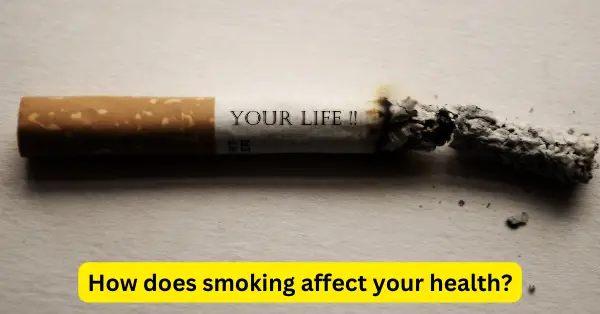Smoking cigarettes is among the most common and hazardous behaviors around the globe. Based on the World Health Organization (WHO) smoking tobacco kills more than 8 million people every year. Smoking is the most significant reason for deaths that can be prevented globally. Smoking cigarettes can have a variety of negative impacts on the body, from minor ailments like bad breath to serious diseases like lung cancer and heart disease. We’ll look at how smoking can affect your health.
Respiratory System
Respiratory system among the areas most affected by smoking cigarettes. Inhaling smoke, it causes irritation in the lungs, leading to inflammation and damages to the delicate tissues. Smoking tobacco can trigger chronic bronchitis, emphysema and chronic obstructive respiratory disease (COPD) that can create coughing and breathing difficulties.
Cardiovascular System
Smoking has a substantial influence upon the cardio system. Smoking causes damage to the linings of blood vessels, leading them to shrink and harden, increasing the chance of having a heart attack and stroke. Smoking also increases the risk of high blood pressure which is a significant risk factor for heart diseases.
Immune System
Smoking lowers your immune system which makes it difficult to help the body fight diseases and infections. Smokers are more prone to respiratory illnesses such as influenza and pneumonia. Additionally, they could be more difficult to recover from these ailments.
Oral Health
Smoking has negative impacts on the oral health. It can lead to bad breath, teeth that are yellow and gum disease. Smoking may also cause oral cancer which is among the most fatal forms of cancer.
Reproductive System
Smoking has a profound effect on the health of reproductive organs. Women who smoke can cause miscarriage, infertility and premature birth. Smoking can also raise the chance of developing cervical cancer. Men who smoke could cause the occurrence of erectile dysfunction, as well as decreased the number of sperm in the body.
Skin Health
Smoking causes premature ageing in the face, wrinkles and other skin-related problems. Smoking can reduce the amount of nutrients and oxygen that get to the skin, which could result in an uneven and dull complexion.
Mental Health
Smoking is also associated with mental health issues like anxiety, depression and stress. They are additionally more likely suffer from issues with addiction and misuse.
Secondhand Smoke
Smoking is not just detrimental to smokers but also the people who are around them. Smoking secondhand can lead to breathing problems, heart disease and lung cancer in non-smokers. This is especially true for children.
Quitting Smoking and the Benefits of Quitting
Smoking less is the single most beneficial option for your overall health. It’s not too late to stop and the results begin very quickly. In just 20 minutes after stopping the heart rate and blood pressure begin to fall. After 24 hours your chance of having a heart attack diminishes and, within 48 hours your senses of taste as well as smell will begin to improve.
In the first year after stopping smoking, your risk of developing heart disease will be cut in half. After 10 years, the risk of lung cancer has been reduced to half. Quitting smoking can result in significant improvements in the respiratory functioning, mental health and overall quality of life.
Quitting smoking cigarettes can be difficult however there are plenty of options to assist. The use of nicotine replacement therapies, such as patches or gum can aid in managing withdrawal symptoms. Support groups and counseling could also be helpful in providing the motivation to keep going and ensuring accountability. Your doctor can assist you to develop a quit strategy that you can follow and may prescribe medication to assist in quitting.
Prevention and Education
While quitting smoking is vital however, stopping smoking from the beginning is more effective. The efforts of prevention and education can help in reducing smoking prevalence particularly among teenagers.
Companies that manufacture tobacco have an extensive track record that has targeted young adults with the use of packaging, advertisements and flavors to make smoking look appealing and trendy. Prevention efforts are focused on countering these messages, informing children about how harmful smoking cigarettes can be and helping them fight the pressure of peers and make healthier decisions.
The efforts to stop smoking have proven effective in a variety of countries as smoking rates have dropped during the past few years. However, there’s plenty of work left to complete, particularly in countries with low or middle incomes where smoking tobacco is rising.
Conclusion
Smoking cigarettes is a risky and fatal habit that has many negative effects on the body. It harms virtually every organ in the body and weakens the immune system as well as increases your risk for contracting a variety of diseases and illnesses.
Stopping smoking is the most effective method to increase your health and decrease the risk of contracting these illnesses. It’s not too late to stop and the benefits start very quickly. Quitting isn’t easy however there are plenty of options to assist you.
Education and prevention efforts can be very efficient in reducing the rate of smoking particularly among younger people. By informing and empowering individuals to make healthier decisions, we can move toward a future where smoking cigarettes is no longer the primary cause of deaths that could be prevented.
In the end, smoking cigarettes can have a profound impact on well-being and health. It is the most beneficial choice you can make for your health as well as those who are around you. With the right tools and guidance, it’s feasible to stop smoking and reap the benefits of a smoke-free existence.

